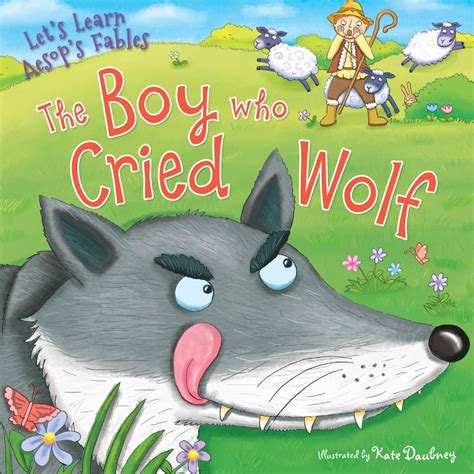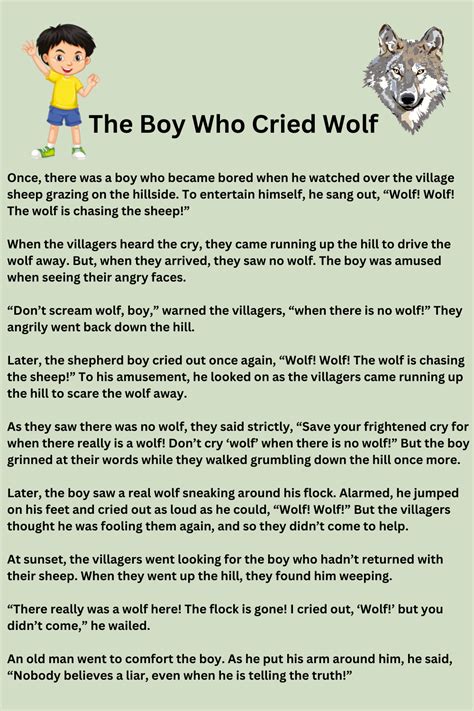The Boy Who Cried Wolf

The timeless tale of "The Boy Who Cried Wolf" has been a cornerstone of children's literature for centuries, imparting valuable lessons about honesty, trust, and the consequences of deception. This ancient fable, attributed to the Greek storyteller Aesop, has been retold and adapted countless times, yet its core message remains as relevant today as it was in antiquity. The story revolves around a young shepherd boy who, tasked with watching over a flock of sheep, repeatedly cries out for help, claiming that a wolf is attacking his charges, despite there being no real danger. His deception ultimately leads to disastrous consequences, as his cries for help are ignored when a wolf finally does appear, and the boy is left to face the predator alone.
The Origins and Evolution of the Fable

The origins of “The Boy Who Cried Wolf” are shrouded in mystery, but it is believed to have originated in ancient Greece, where Aesop’s fables were first shared orally before being written down. The story has undergone numerous adaptations and interpretations over the centuries, with various cultures adding their own unique twists and moral lessons. Despite these variations, the core theme of the story has remained relatively consistent, serving as a cautionary tale about the dangers of dishonesty and the importance of trustworthiness. One of the key aspects of the fable is its ability to transcend cultural and linguistic boundaries, making it a universal tale that can be understood and appreciated by people from diverse backgrounds.
Psychological and Social Implications
From a psychological perspective, “The Boy Who Cried Wolf” can be seen as a classic example of the boy-who-cried-wolf effect, where an individual’s repeated false alarms lead to a decrease in trust and credibility. This phenomenon has been observed in various real-world contexts, including emergency services, where false alarms can lead to a decrease in response times and effectiveness. Social learning theory also plays a significant role in the story, as the boy’s behavior is shaped by his environment and the consequences of his actions. The tale highlights the importance of consequences and accountability in shaping behavior and promoting prosocial values.
| Version | Date | Notable Features |
|---|---|---|
| Aesop's Original | 6th century BCE | Simple, concise narrative with a clear moral lesson |
| Medieval Adaptation | 12th century CE | Added Christian allegory and symbolism |
| Modern Retelling | 20th century CE | Increased focus on character development and psychological insights |

Key Points
- The story of "The Boy Who Cried Wolf" has been a part of children's literature for centuries, imparting valuable lessons about honesty and trust.
- The tale has undergone numerous adaptations and interpretations, with various cultures adding their own unique twists and moral lessons.
- The story highlights the importance of consequences and accountability in shaping behavior and promoting prosocial values.
- The boy-who-cried-wolf effect has been observed in various real-world contexts, including emergency services, where false alarms can lead to a decrease in response times and effectiveness.
- The tale serves as a cautionary story about the dangers of dishonesty and the importance of trustworthiness, making it a universal message that can be understood and appreciated by people from diverse backgrounds.
Applications and Implications in Modern Society

The lessons learned from “The Boy Who Cried Wolf” can be applied to various aspects of modern society, including politics, media, and personal relationships. In the age of social media, where information can spread rapidly and false news can go viral, the story serves as a timely reminder of the importance of verifying information before sharing it. Moreover, the tale highlights the need for accountability and consequences in shaping behavior and promoting responsible actions. By analyzing the story through the lens of social psychology and communication theory, we can gain a deeper understanding of the mechanisms underlying trust, deception, and credibility.
Teaching Moral Lessons and Promoting Critical Thinking
One of the most significant contributions of “The Boy Who Cried Wolf” is its ability to teach moral lessons and promote critical thinking in children and adults alike. The story encourages readers to reflect on the consequences of their actions and to consider the impact of their behavior on others. By analyzing the boy’s motivations and actions, readers can develop a deeper understanding of the psychological and social factors that drive human behavior. Moreover, the tale serves as a cautionary story about the dangers of deception and the importance of trustworthiness, making it a valuable tool for promoting prosocial values and responsible behavior.
What is the main moral lesson of "The Boy Who Cried Wolf"?
+The main moral lesson of the story is the importance of honesty and trustworthiness, as well as the consequences of deception and dishonesty.
How can the story be applied to modern society?
+The story can be applied to various aspects of modern society, including politics, media, and personal relationships, highlighting the importance of verifying information, accountability, and consequences in shaping behavior and promoting responsible actions.
What are some of the psychological and social implications of the story?
+The story has significant psychological and social implications, including the boy-who-cried-wolf effect, social learning theory, and the importance of consequences and accountability in shaping behavior and promoting prosocial values.
Meta description suggestion: “Discover the timeless lessons of ‘The Boy Who Cried Wolf’, a classic fable about honesty, trust, and the consequences of deception, with insights into its origins, psychological implications, and modern applications.”